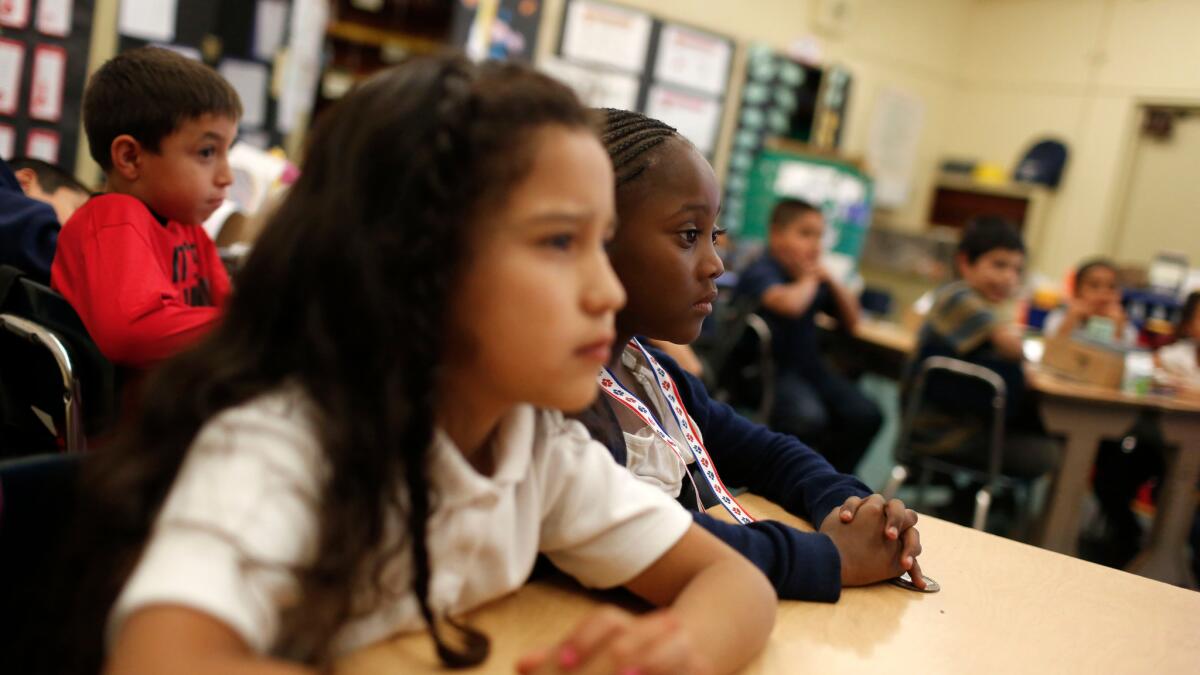‘Get to green:’ California wants to grade school performance with colors instead of a single number

For the last 15 years, a number between 200 and 1,000 told parents in California how good their child’s school was.
Up next: They might have to decipher performance through a series of colored boxes.
For the record:
11:20 a.m. July 14, 2016A previous version of this article included an image from Education Trust—West’s proposed display for parents. The group is still working on the display.
California is in the process of redefining its system for rating public schools, in a way that is both transparent for parents and more precise than just using test scores. The changes come after the number system, called the Academic Performance Index, was suspended and as the state tries to satisfy the Every Student Succeeds Act, the federal government’s replacement of No Child Left Behind.
The latest proposal, presented Wednesday at a meeting of the State Board of Education in Sacramento, is “the California Model,” a display of 17 colored boxes that summarizes how a school is doing in such categories as math or career readiness, both in terms of current status and progress over time.
Performance is rated on indicators set by state and federal law as well as those evaluated under the state’s new school funding formula.
Though officials cautioned the draft was preliminary, it engendered a long debate over graphics, with one board member begging to move away from “Easter egg” colors because one pastel-tinged draft didn’t seem serious enough.
A school in the red on graduation means that too many students are dropping out; the best color ranking would be blue. To understand what each color means in a particular category, parents could refer to a “lookup table,” a grid of 25 colored boxes explaining in more detail what it means to be labeled a certain color.
Eric Crane, a designer of the mock-up from the nonprofit consulting firm WestEd, presented a slideshow showing how year-over-year progress doesn’t always improve a school’s color standing.
“There’s no hiding performance that would be of concern,” he said. The short- and long-term goals, he said, would be for schools to “get to green.”
The new federal law requires states to “meaningfully differentiate” between schools that are doing better and worse, and the federal government has proposed regulations that would require each school to get an overall rating.
But the proposal presented Wednesday did not provide an overall rating of each California school. The board voted to send a letter to the feds that will include their feedback on the regulations.
The display — which, board members cautioned is the forerunner of a website that will contain much more information — was the subject of an hours-long discussion.
It’s also the product of months of debate over how to better represent what happens inside schools, after years of using a single number largely based on standardized test scores.
But some said the proposed color-coded system had become too convoluted in an effort to include more and more factors in the ratings.
“Several aspects of the latest version seem overly complicated,” said Patty Scripter, vice president for education of the California State PTA. “We encourage the board to pilot-test the words and colors with parents.”
Gabe Rose, the chief strategy officer for Parent Revolution, which has helped parents change management at many public schools, said, “Our No. 1 concern continues to be whether or not the system is easily usable for all families. Unfortunately, right now we feel the answer is no.”
State Board of Education president Mike Kirst said there is time for the design to be refined.
Education Trust — West, a California-based advocacy group, sent the state education department a letter saying it had “major concerns and questions about how these many indicators and data points fit together.” The letter also contended that it’s unclear how the evaluation of local funding formulas fit into the state reporting tool. The group is working on an alternative proposal for a school report card display for parents.
In May, the education board voted on many components to be included in the school report card: English and math test scores and growth on those exams, high school graduation rates, suspension rates, measures of college preparedness, chronic absenteeism and how quickly English language learners are absorbing the language.
Also on Wednesday, the board voted to approve details concerning several more measures of how schools should be evaluated including a measure of college and career readiness that takes 11th grade test scores into account.
It also approved the use of surveys on “school climate,” a measure of how safe students feel in school and the inclusion of an “equity report,” which signals how well schools are serving specific groups of students, such as minority groups.
The board is slated to vote on a final plan in September.
As the board debated, a group of about 50 students organized by Californians for Justice stood outside the Department of Education building and took turns talking about what they wanted from the board.
“Gov. Jerry Brown,” one student said, “you have an all-important role in working with students to close the achievement gap. We are asking you to believe in us.”
More to Read
Sign up for Essential California
The most important California stories and recommendations in your inbox every morning.
You may occasionally receive promotional content from the Los Angeles Times.











